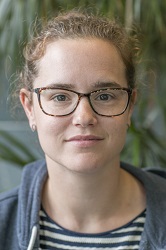Ayla Paul

Areas of interest
- Stable isotopes in ecology
- Dietary composition in ecology
- Food authenticity
Research centres and groups
Environmental Science Research DivisionResearch projects
Provenance, governance, and traceability of UK honey: combining stable isotope ratio mass spectrometry, trace element analysis and pollen identification
Part of NERC QMEE CDT, this project analyses honey samples to analyse the provenance, governance, and traceability of UK honey. The project seeks to develop a multi-proxy, cost-effective authentication protocol for the UK honey industry by understanding the trace element and isotopic signals and combining these with the melissopalynology.
The project will integrate, for the first time, evidence from stable isotopes, pollen identification and trace elements analysis to provide robust and repeatable evidence of the provenance, authenticity and traceability of UK honey and an understanding of the nature of these signals in honey.
This novel, multi-disciplinary research aims to provide practical solutions to detect fraud and authenticate the botanical source(s) of honey in the UK.
Supervisors:
- Dr Stuart Black (University of Reading)
- Dr Rob Batchelor (QUEST, University of Reading)
Contact:
- a.paul@pgr.reading.ac.uk
- Twitter: @aylapaul
Background
I hold a Bachelor degree (with Distinction) in Forestry & Nature Management from the University of Applied Sciences Larenstein, Velp (the Netherlands) and an MSc (with Distinction) in Wildlife Management and Conservation from the University of Reading.
My MSc dissertation studied the dietary composition of the Common Buzzard during the breeding season in relation to habitat type, on the Langholm Moor, Southern Scotland, as part of the Langholm Moor Demonstration Project, between April 2013 and September 2013.
I have worked as an Assistant Ecologist conducting ecological surveys (Phase 2 Habitat surveys, bat and reptile surveys, and raptor surveys) prior to commencing my PhD. I have a special interest in art, and looking for ways in my spare time to combine science and art to communicate science to a wider audience.